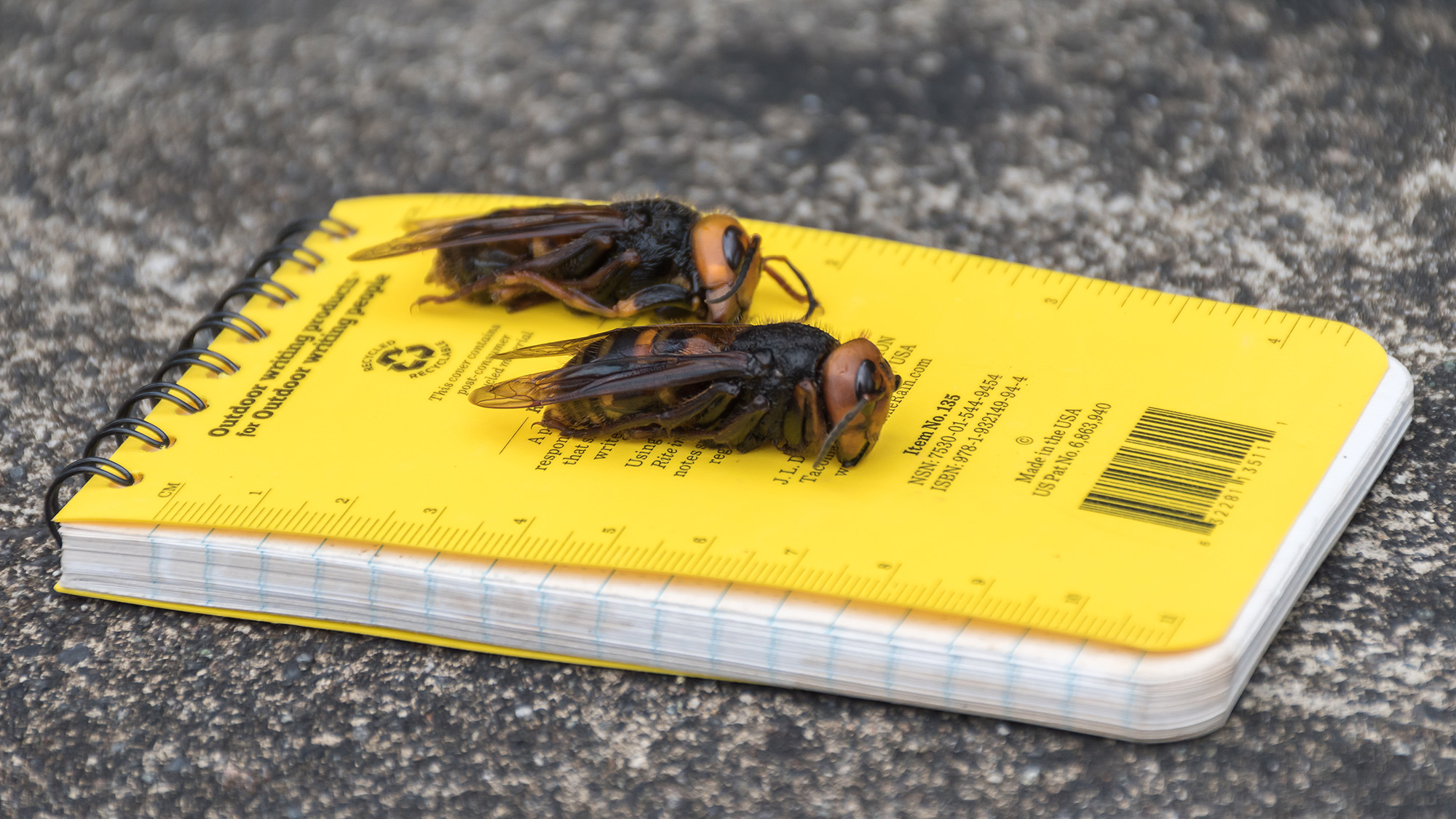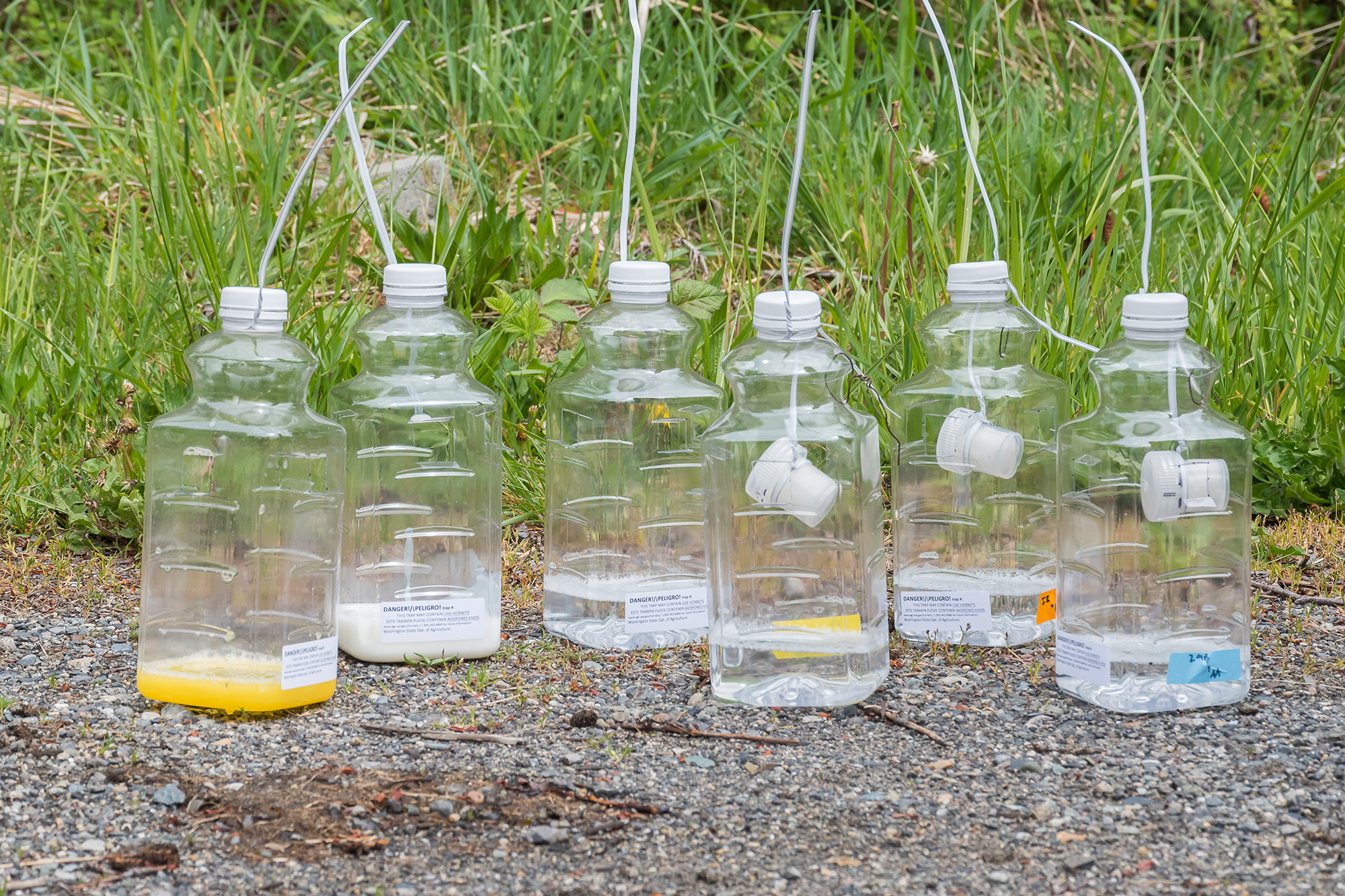“It's been just totally insane here,” Salp said Monday. “I've worked here since 2015 and this far exceeds anything that I have ever dealt with in communication. We just had another outreach person start today, bless her heart … so she’s definitely experiencing a little bit of baptism by fire.”
The New York Times first covered the Asian giant hornet’s presence in Washington in December, but the Department of Agriculture has been sharing identifying information with the public at least since publishing a revised invasive species pamphlet in October. The first of two dead detected specimen in Washington state was reported late last year near Blaine in Whatcom County.
But the most recent news of “murder hornets” has captured international attention and monopolized the waking hours of insect, forestry and agriculture professionals in the ground zero state of Washington.
There are plenty of reasons to fear this hornet: It’s big, it turns its preferred forest floor habitat into landmines of underground hives, it can sting multiple times, and it can deliver seven times as much toxin per sting as a honeybee and can pierce a bee suit. About 50 people die in Japan from Asian giant hornet stings every year, hence the nickname.
Salp and others say they appreciate the hundreds of emails, calls and sighting reports; the department hosts an Asian Giant Hornet Facebook group that nearly tripled in size after the New York Times article dropped. But those involved in the study and eradication of these hornets in Washington state say that for most people the panic far outweighs realistic concerns, at least for now.
So far, none but the original two specimen reports have turned up positive identifications. Salp says the most popular species misidentified as Asian giant hornets are European hornets (which aren’t known to exist in Washington); cicada killers; yellow jackets; or bumblebees. The Department of Agriculture offers education around bumblebee identification to prevent people from killing them in error.
With most Americans sheltering during the pandemic, the murder hornet has clearly struck a nerve.
Todd Murray, director of the Agricultural and Natural Resources Extension Program Unit at Washington State University, says he thinks the “murder hornet” nickname is driving interest. “Note to self: Stick ‘murder’ in front of it and it sure gets attention,” Murray says.
He and his colleagues are fielding a couple of dozen media requests a day. “It’s interesting because in the entomology community, there's some strong feelings about the stigma around wasps and hornets,” he says, ”so there’s been backlash within our own community about the term.”
‘We don’t need to freak out’
With only two confirmed hornet sightings, only a few groups of people have reason to be afraid right now, experts say. “We don't need to freak out, you know, but it is a serious concern for our state,” Salp says.
“This isn't an issue that we need to panic about, especially in light of the pandemic,” adds Murray. “But I think there’s a benefit of being aware of what it’s like to live in a global economy, a global environment, where we have people and products constantly moving across the world. And we are bound to get hitchhikers like this one — and in Washington state it's become all too common for new insects to be introduced. Early detection is really critical.”
To the best of the state’s knowledge, the hornet hasn’t been seen outside of Whatcom County: The two sightings that were verified were near Blaine. A hive was also eradicated in Nanaimo in British Columbia after a specimen was discovered in August 2019. “If you live outside of those areas, I would have less concern, but still have an awareness and then definitely be thinking about your connection to those areas” says Justin Bush, executive coordinator with the Washington Invasive Species Council. For instance, if you live along Interstate 5, that could be a pathway for accidental hornet trafficking by semitruck or RV. “But naturally, if they fly, the spread is a little bit slower than that,” Bush says.

Murray says that he would definitely be aware if he were in Blaine in semiforested conditions or where forest meets open fields.
Salp says Washington’s honeybees and the beekeepers and farmers who depend on them for honey and pollination have more serious reasons to be alarmed. The Asian giant hornets’ appetite for honeybees is enormous. The hornets take over beehives, chewing off the bees’ heads before feeding on their bodies. “They will defend that hive as their own, and if you try to approach or get them out of your hive yourself, you have a very high probability of being stung,” Salp says. The hornets can chew through more than 40 bees a minute and destroy a hive in 90 minutes.
With American honeybees already disappearing at an alarming rate, the invasive hornet further endangers the $20 billion sector of the U.S. farming industry that honeybees support. (A 2014 state report found bees in 2012 “added billions of dollars in harvest value to Washington’s economy, including nearly $3 billion from tree fruit and berries. The bees themselves added nearly $4 million from honey sales, but their chief value is as pollinators.”)
Murray says beekeepers are likely to be the first people to encounter the hornets this year if there’s an active population, but that might not be clear until late summer or early fall, when the hornets engage in their bee-killing sprees.
Ann Potter, a conservation biologist and insect specialist with the Washington Department of Fish and Wildlife, says she’s not aware of the hornets’ impacts on insect species other than honeybees, “but certainly there must be.... It’s unlikely to feed on only one species.” She notes that the European honeybees raised by beekeepers may be more vulnerable to hornets than also-declining native bees because they live in large colonies. (Japanese honeybees, on the other hand, protect themselves by cooking the Asian giant hornets alive.)
People allergic to wasp, bee, or hornet stings are vulnerable as well: Asian giant hornets carry more venom per sting than local bees and wasps. According to the Cleveland Clinic, about 2 million Americans are allergic to these types of stings, and approximately 50 people die every year from allergic reactions from them.
However, anyone who works or enjoys outdoor recreation should at least be aware and able to identify and report the giant hornets, Salp says — “not because Asian giant hornets are going to come after you, but [because] if you see them, we definitely want to know about it.”
“We don't know how they're going to interact with [our] environment,” Murray says. “We really don't want this hornet to establish here in the Pacific Northwest because we really don't know exactly how much it will impact our ecology and agriculture and, honestly, our daily life.”
Don’t panic — yet
Murray says he would be more concerned if people submitted sightings of the hornet over a much broader area than where they’ve been spotted, but he says there’s no reason to think it’s present elsewhere in the state yet. That means 2020 will be a critical year for trapping hornets and educating the public.
“The challenge is we don't really know exactly how widespread it is for sure,” Salp says. Washington is home to vast amounts of the deep forest habitat the hornets prefer, and they are excellent fliers. Murray says some data show the hornets can forage up to 5 miles from their nesting site.
Europe has been dealing with the invasion of a similar species called the yellow-legged hornet since at least 2004: Thought to have arrived in bonsai tree shipments, the hornets have yet to be eradicated. Murray says honey production has decreased by up to two-thirds in Europe.
The only way to eradicate the bees, Salp says, is to track them back to their hives through live trapping, tagging and release because the colonies are almost always underground.
Murray says he’s “pretty optimistic” the hornet can be eradicated because the state was able to note its presence in December with the public's help. “If we ignored this problem, each year that we get generation turnover, it would be likely significantly more difficult and very expensive to try and eradicate this,” he says.

For people hoping to help the department take advantage of this critical window, Salp says the public should make sure to share and reference information only from reliable sources like Washington State University or the Department of Agriculture. They should submit possible sightings to the department via its web app with complete identifying information. Murray says if you see a live one, run and note your location for later. The Washington Invasive Species Council's Bush recommends sending photos, a GPS location and contact information in case someone with the state needs to follow up.
“With invasive species, especially ones that are relatively new [and high priority], a high percentage [of identifications] are going to be inaccurate,” Bush says. “And that's OK, because the 1% or less than 1% [of IDs] that are accurate could help avoid millions if not billions of dollars of impact, that could potentially not be reversible.”
Murray says identifying an Asian giant hornet is easy. The Pacific Northwest is home to few large, flying insects. “The person that first detected it saw it come into a hummingbird feeder and it sure was obvious on its own. Some of our native beetles might get that large, but these look strikingly different.”
People in Whatcom, Skagit, San Juan, Jefferson and Clallam counties can also sign up for volunteer trapping, which Bush says is best done in June and July. The Department of Agriculture got state and federal funding for the trapping project, but there’s still limited capacity, Salp says. The pandemic is complicating tracking efforts as well. In-person trainings in Western Washington were canceled. There were also plans for specimen drop-offs at WSU, but now samples can be taken only by mail until stay-at-home restrictions are lifted.
"Between the beekeepers, the volunteers and our own staff, the project is moving forward — [but] this is all frankly kind of one big experiment,” Salp says. “The more folks that we have out there helping trap for them, the greater our chances of finding them and then eradicating them.”
Useful resources:
— How to identify Asian giant hornets
— How to trap Asian giant hornets
— How to submit Asian giant hornet sightings to the Washington State Department of Agriculture




